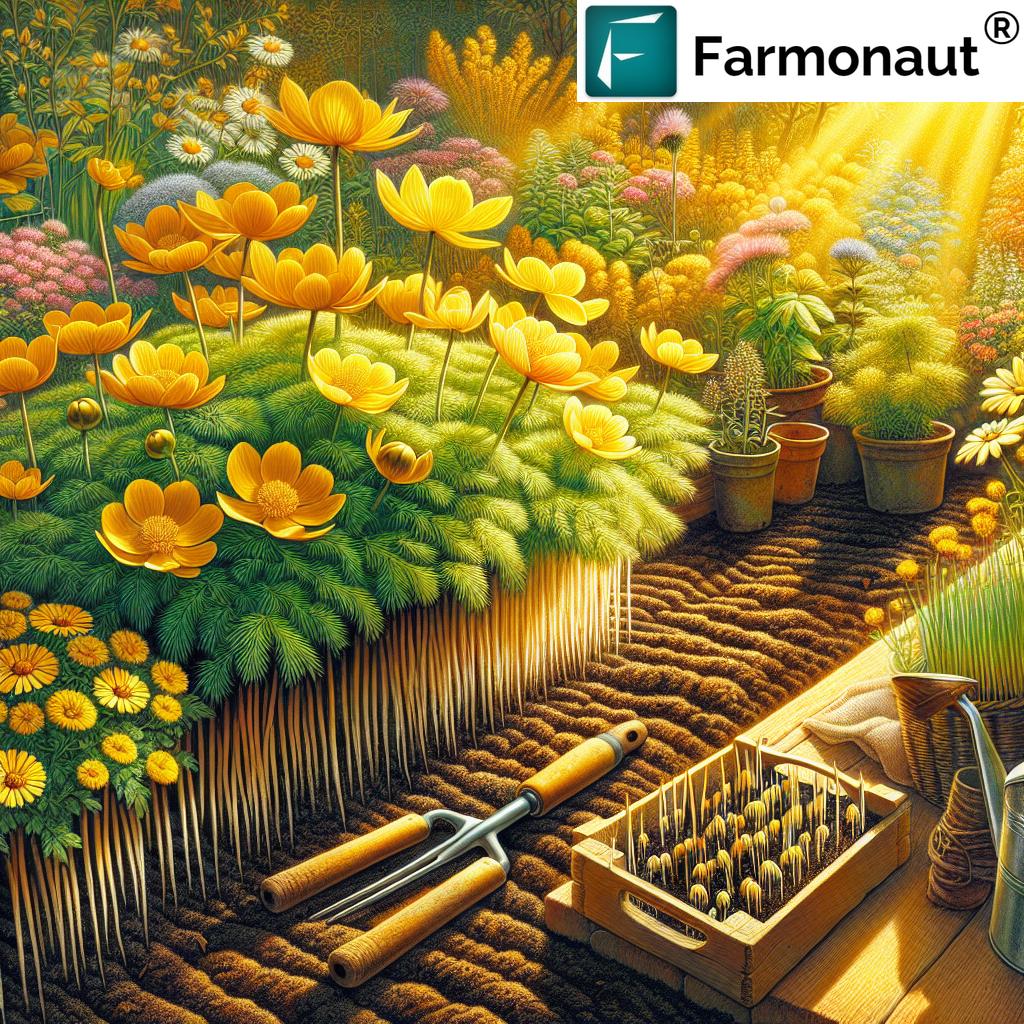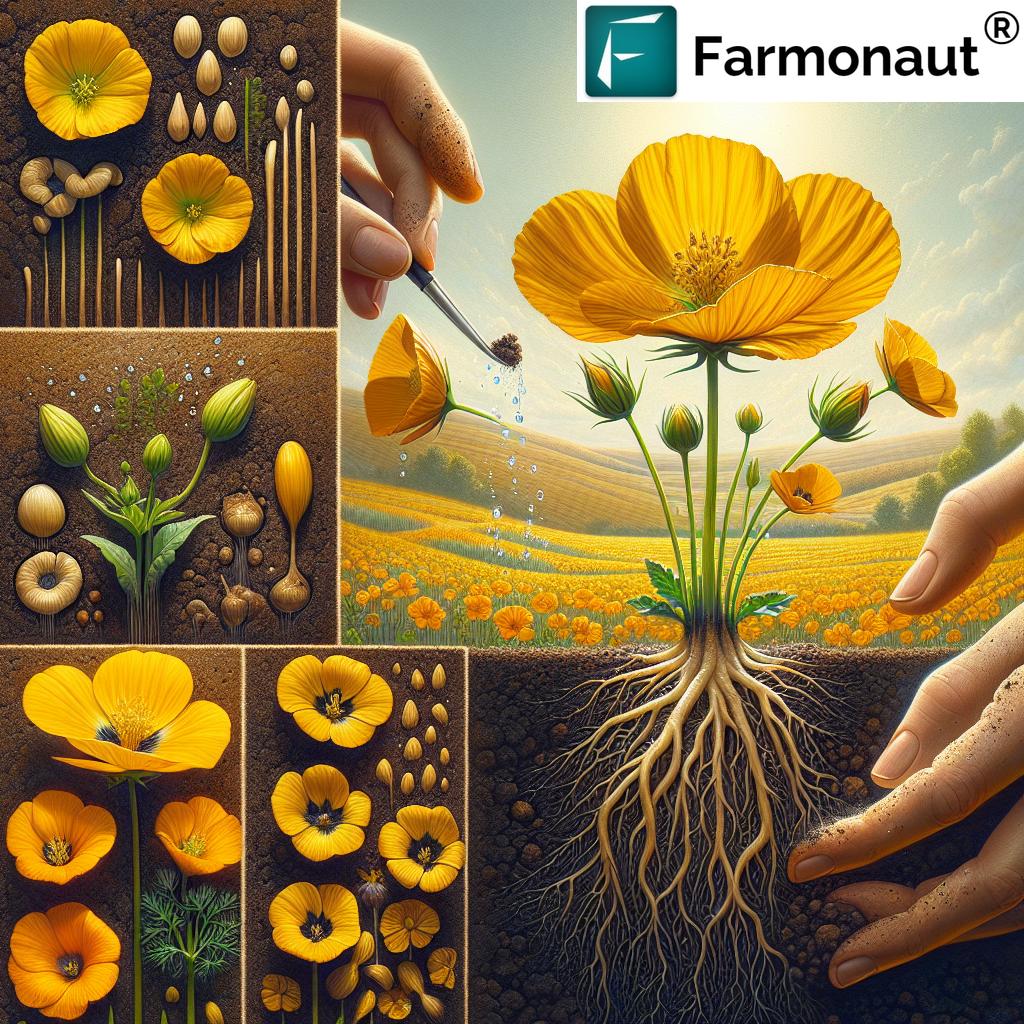Mastering Aurinia: A Canadian Guide to Growing Lush Golden Blooms in Your Garden
“Aurinia plants can produce up to 100 golden flowers per stem, creating a stunning visual impact in gardens.”
Welcome to our comprehensive guide on growing aurinia, the stunning basket of gold plant that can transform your Canadian garden into a sea of golden blooms. Whether you’re a novice gardener or an experienced horticulturist, this guide will provide you with all the information you need to successfully cultivate these lush, evergreen perennials. We’ll explore everything from soil preparation to planting techniques, care tips, and even how to leverage modern agritech solutions to enhance your gardening success.
Understanding Aurinia: The Golden Wonder of Canadian Gardens
Aurinia, commonly known as basket of gold or gold alyssum, is a hardy evergreen perennial that brings a vibrant splash of color to spring gardens. Native to Europe but well-adapted to Canadian climates, aurinia saxatilis is particularly popular for its ability to thrive in rocky or sandy soils, making it an excellent choice for rock gardens, borders, and even as ground cover.

These low-growing plants form dense mats of silvery-green foliage, which burst into brilliant golden flowers in early spring. The flowers, resembling tiny daisies or asters, carpet the plant in a stunning display that can last for several weeks. With proper care and attention, aurinia can become a show-stopping feature in your Canadian garden, returning year after year with its golden glory.
Preparing Your Garden for Aurinia
Before we dive into the planting process, it’s crucial to prepare your garden to provide the optimal growing conditions for aurinia. These hardy plants have specific preferences that, when met, will ensure robust growth and abundant blooming.
Soil Preparation: The Foundation of Healthy Aurinia
- Well-drained soil: Aurinia thrives in well-drained soil. If your garden has heavy clay soil, consider amending it with sand or grit to improve drainage.
- pH level: These plants prefer slightly alkaline to neutral soil with a pH between 6.0 and 7.5. Test your soil and adjust if necessary using lime to raise pH or sulfur to lower it.
- Organic matter: While aurinia doesn’t require rich soil, incorporating some compost can improve soil structure and provide essential nutrients.
Remember, proper soil preparation is key to growing lush aurinia blooms. By ensuring your soil meets these requirements, you’re setting the stage for healthy, vigorous plants that will reward you with a stunning golden display.
Choosing the Right Location
Aurinia is a sun-loving plant that performs best in full sun to partial shade. When selecting a spot in your garden, consider the following:
- Sun exposure: Aim for at least 6 hours of direct sunlight daily for optimal flowering.
- Air circulation: Good air flow helps prevent fungal diseases, especially in humid climates.
- Space: Allow about 12-18 inches between plants to accommodate their spreading habit.
By carefully selecting the right location, you’re ensuring that your aurinia plants will have the best chance to thrive and produce those coveted golden blooms.
Planting Aurinia: From Seeds to Seedlings
Now that we’ve prepared the perfect growing environment, let’s explore the various methods of planting aurinia in your Canadian garden.
Starting Aurinia from Seeds
Growing aurinia from seeds is an economical way to introduce these golden beauties to your garden. Here’s how to get started:
- Timing: Start seeds indoors 6-8 weeks before the last expected frost date in your area.
- Sowing: Use a sterile seed-starting mix and sow seeds lightly on the surface, as they need light to germinate.
- Germination: Keep the soil moist but not waterlogged. Seeds typically germinate in 14-21 days at temperatures around 65-70°F (18-21°C).
- Care: Once seedlings emerge, provide plenty of light and maintain consistent moisture.
Indoor seed starting techniques are crucial for getting a head start on the growing season, especially in cooler Canadian climates. By starting your aurinia seeds indoors, you’re giving them a chance to develop into strong seedlings ready for transplanting when spring arrives.
Transplanting Seedlings Outdoors
When your aurinia seedlings have grown strong enough and the danger of frost has passed, it’s time to transplant them to your garden:
- Hardening off: Gradually expose seedlings to outdoor conditions over 7-10 days to acclimatize them.
- Planting: Choose a cloudy day or late afternoon to transplant. Dig holes twice the size of the root ball and space plants 12-18 inches apart.
- Watering: Water thoroughly after planting to help settle the soil around the roots.
- Mulching: Apply a thin layer of organic mulch around plants to retain moisture and suppress weeds.
Proper transplanting techniques are essential for helping your aurinia seedlings establish themselves in their new outdoor home. With care and attention during this critical phase, you’ll soon see your plants thriving in the garden.
Caring for Your Aurinia: Nurturing Golden Blooms
“Proper deadheading of Aurinia can extend its blooming period by up to 4 weeks, maximizing the golden display.”
Once your aurinia plants are established in the garden, they require relatively low maintenance. However, proper care will ensure the most vibrant and long-lasting blooms.
Watering and Moisture Management
Aurinia is drought-tolerant once established, but proper watering is crucial for healthy growth and abundant flowering:
- Frequency: Water deeply but infrequently, allowing the soil to dry slightly between waterings.
- Technique: Water at the base of the plant to avoid wetting the foliage, which can lead to fungal issues.
- Mulching: Maintain a thin layer of mulch to conserve moisture and regulate soil temperature.
Remember, overwatering can be more detrimental than underwatering for aurinia. These plants prefer well-drained soil and are susceptible to root rot in waterlogged conditions.
Fertilizing for Optimal Growth
Aurinia doesn’t require heavy fertilization, but a light feeding can promote healthy growth and abundant blooming:
- Timing: Apply a balanced, slow-release fertilizer in early spring as new growth emerges.
- Amount: Use a light hand – too much fertilizer can lead to excessive foliage growth at the expense of flowers.
- Organic options: Compost or well-rotted manure can be an excellent natural alternative to chemical fertilizers.
By providing just the right amount of nutrients, you’ll encourage your aurinia to produce those stunning golden blooms that make it a garden favorite.

Pruning and Deadheading
Regular pruning and deadheading are essential for maintaining the shape and prolonging the blooming period of your aurinia:
- Deadheading: Remove spent flowers regularly to encourage continued blooming and prevent self-seeding.
- Shaping: After flowering, trim back the foliage by about one-third to maintain a compact shape and prevent legginess.
- Dividing: Every 3-4 years, divide mature plants in early spring or fall to rejuvenate them and create new plants.
These simple maintenance tasks can significantly extend the flowering season of your aurinia, ensuring your garden remains awash with golden blooms for weeks on end.
Companion Planting: Enhancing Your Aurinia Garden
Companion planting is a fantastic way to create a harmonious and visually striking garden while also promoting plant health and biodiversity. When it comes to aurinia, several plants make excellent companions:
- Dianthus: The pink or white flowers of dianthus provide a beautiful contrast to aurinia’s golden blooms.
- Creeping Phlox: This low-growing plant flowers at the same time as aurinia, creating a colorful carpet effect.
- Sedum: Drought-tolerant sedums complement aurinia’s water needs and add textural interest.
- Candytuft: Another spring-blooming perennial that pairs well with aurinia in rock gardens.
Companion planting benefits go beyond aesthetics. By choosing plants with similar growing requirements, you can create a more balanced ecosystem in your garden, potentially reducing pest problems and improving overall plant health.
Overcoming Common Challenges in Aurinia Cultivation
While aurinia is generally a low-maintenance plant, Canadian gardeners may face a few challenges when growing these golden beauties. Here are some common issues and how to address them:
Pest Management
- Aphids: These small insects can sometimes infest aurinia. Combat them with insecticidal soap or a strong stream of water.
- Slugs and Snails: These pests can damage young plants. Use organic slug baits or create barriers with crushed eggshells or diatomaceous earth.
Disease Prevention
- Root Rot: Ensure well-drained soil to prevent this fungal disease. If plants show signs of wilting despite moist soil, improve drainage immediately.
- Leaf Spot: Remove affected leaves and avoid overhead watering to prevent the spread of this fungal issue.
Climate Considerations
- Winter Protection: In colder regions of Canada, provide a layer of mulch around the base of plants to protect roots from freeze-thaw cycles.
- Summer Heat: In areas with extremely hot summers, provide some afternoon shade to prevent leaf scorch.
By staying vigilant and addressing these issues promptly, you can ensure your aurinia plants remain healthy and vibrant throughout the growing season.
Leveraging Technology for Aurinia Success
In today’s digital age, gardeners have access to a wealth of technological tools that can enhance their growing experience. One such innovative solution is Farmonaut, a satellite-based crop monitoring system that can be adapted for garden use.
Farmonaut’s web app offers real-time insights into vegetation health, soil moisture levels, and weather patterns, which can be invaluable for aurinia cultivation. By monitoring these factors, you can make informed decisions about watering, fertilization, and pest management, ultimately leading to healthier plants and more abundant blooms.
For those interested in more advanced features, Farmonaut also offers an API that allows for integration with other gardening tools and apps. The API Developer Docs provide detailed information on how to leverage this technology for your gardening projects.
Additionally, Farmonaut’s mobile apps for Android and iOS allow you to monitor your aurinia garden on the go, ensuring you never miss a crucial watering or feeding.
Sustainable Gardening Practices for Aurinia
As responsible gardeners, it’s essential to consider the environmental impact of our practices. Here are some sustainable approaches to aurinia cultivation:
- Water Conservation: Use mulch and drip irrigation to minimize water waste.
- Natural Pest Control: Encourage beneficial insects by planting native flowers nearby.
- Composting: Create your own nutrient-rich soil amendment by composting garden and kitchen waste.
- Native Plant Integration: Combine aurinia with native Canadian plants to create a balanced, eco-friendly garden.
By adopting these sustainable gardening practices, you’re not only nurturing your aurinia plants but also contributing to a healthier environment.
Aurinia in Canadian Landscapes: Design Ideas
Aurinia’s versatility makes it an excellent choice for various garden designs. Here are some creative ways to incorporate these golden blooms into your Canadian landscape:
- Rock Gardens: Aurinia’s low-growing habit and tolerance for poor soil make it ideal for rock gardens.
- Border Edging: Use aurinia to create a golden border along pathways or flower beds.
- Slope Stabilization: Plant aurinia on slopes to help prevent erosion while adding beauty.
- Container Gardens: Grow aurinia in pots or hanging baskets for a burst of color on patios and balconies.
- Wildflower Meadows: Incorporate aurinia into naturalistic plantings for a touch of golden elegance.
By thinking creatively about placement and design, you can maximize the impact of your aurinia plants and create stunning garden vistas.
Aurinia Through the Seasons: Year-Round Care
While aurinia is known for its spectacular spring display, proper care throughout the year ensures healthy plants and consistent blooms. Let’s explore seasonal care tips:
Spring
- Remove winter mulch and clear away any debris.
- Apply a light fertilizer as new growth emerges.
- Deadhead regularly to prolong blooming.
Summer
- Provide supplemental water during dry spells.
- Trim back foliage after flowering to maintain shape.
- Monitor for pests and diseases, addressing issues promptly.
Autumn
- Reduce watering as temperatures cool.
- Clean up fallen leaves to prevent disease.
- Consider dividing overgrown plants.
Winter
- Apply a layer of mulch to protect roots from freeze-thaw cycles.
- Avoid walking on frozen ground near plants to prevent root damage.
- Plan for next year’s garden and order seeds if needed.
By providing appropriate care throughout the year, you ensure that your aurinia plants remain healthy and ready to put on a stunning show come spring.
Aurinia Varieties: Exploring Golden Options
While Aurinia saxatilis is the most common species grown in gardens, there are several cultivars and related species worth considering:
- ‘Compacta’: A dwarf variety perfect for small spaces or rock gardens.
- ‘Citrina’: Features pale yellow flowers for a softer look.
- ‘Gold Ball’: Offers particularly large, vibrant golden blooms.
- ‘Summit’: Known for its neat, mounded habit and profuse flowering.
Experimenting with different aurinia varieties can add depth and interest to your garden, allowing you to create stunning golden displays tailored to your specific preferences and growing conditions.
Aurinia Growing Conditions: Optimal vs. Suboptimal
| Growing Condition | Optimal | Suboptimal |
|---|---|---|
| Soil Type | Well-drained, slightly alkaline | Poorly drained, acidic |
| Sun Exposure | Full sun to partial shade | Full shade |
| Watering Frequency | Moderate, allowing soil to dry between waterings | Frequent, keeping soil constantly moist |
| Temperature Range | -30°C to 30°C (-22°F to 86°F) | Above 35°C (95°F) or prolonged freezing |
| Companion Plants | Dianthus, Creeping Phlox, Sedum | Water-loving or shade-preferring plants |
Conclusion: Embracing the Golden Beauty of Aurinia
As we’ve explored in this comprehensive guide, growing aurinia in Canadian gardens is a rewarding experience that brings a touch of golden magic to your outdoor space. From understanding the plant’s needs to mastering planting techniques and year-round care, you now have the knowledge to cultivate lush, vibrant aurinia blooms.
Remember, successful gardening is about patience, observation, and continuous learning. Don’t be afraid to experiment with different varieties, companion plants, and garden designs to find what works best in your unique environment. And don’t forget to leverage modern tools like Farmonaut’s satellite-based monitoring to give your plants the best possible care.
With its low maintenance requirements, drought tolerance, and stunning spring display, aurinia is an excellent choice for Canadian gardeners looking to add a splash of gold to their landscape. So roll up your sleeves, get your hands dirty, and watch as your garden transforms into a sea of golden blooms!
FAQs About Growing Aurinia
- How long does it take for aurinia to bloom after planting?
Aurinia typically blooms in its second year after planting from seed. When planted from nursery starts, it may bloom the first spring after planting. - Can aurinia grow in containers?
Yes, aurinia can thrive in containers as long as they have good drainage and are placed in a sunny location. - Is aurinia deer resistant?
Aurinia is generally considered deer resistant due to its fuzzy leaves, making it a good choice for gardens in areas with high deer populations. - How often should I divide my aurinia plants?
Aurinia plants benefit from division every 3-4 years to maintain vigor and prevent the center from becoming woody and sparse. - Can aurinia be grown indoors?
While aurinia is primarily an outdoor plant, it can be grown indoors in a very bright location with cool temperatures and excellent air circulation.
We hope this guide has inspired you to incorporate the golden beauty of aurinia into your Canadian garden. Happy gardening!
Explore Farmonaut’s solutions to enhance your gardening experience:




















